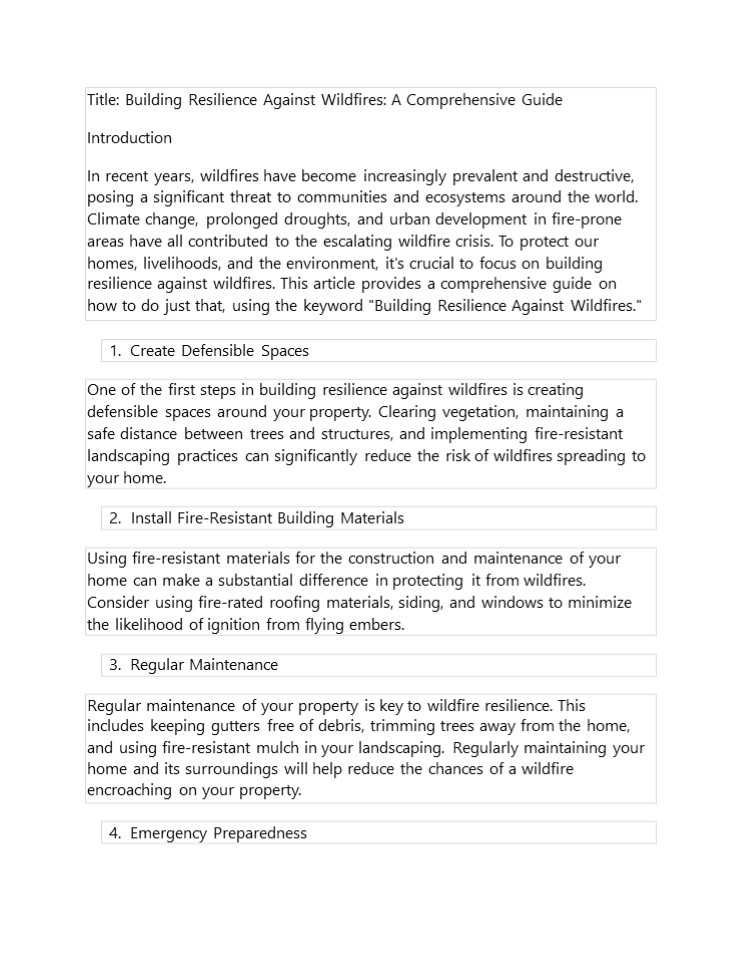Building Resilience Against Wildfires - PowerPoint PPT Presentation
Title:
Building Resilience Against Wildfires
Description:
Building resilience against wildfires requires a multifaceted approach that encompasses both proactive measures and community preparedness. This involves implementing land management strategies such as controlled burns and defensible space around homes, coupled with robust firefighting resources and technology. Additionally, public education and awareness campaigns play a vital role in encouraging responsible fire prevention practices and evacuation readiness. Climate change mitigation efforts and zoning regulations also need to be part of the equation to reduce the frequency and intensity of wildfires. Ultimately, building resilience against wildfires is a collective effort that demands collaboration among individuals, communities, and government agencies to protect lives, property, and the environment. – PowerPoint PPT presentation
Number of Views:1
Title: Building Resilience Against Wildfires
1
Title Building Resilience Against Wildfires A
Comprehensive Guide Introduction In recent
years, wildfires have become increasingly
prevalent and destructive, posing a significant
threat to communities and ecosystems around the
world. Climate change, prolonged droughts, and
urban development in fire-prone areas have all
contributed to the escalating wildfire crisis. To
protect our homes, livelihoods, and the
environment, it's crucial to focus on building
resilience against wildfires. This article
provides a comprehensive guide on how to do just
that, using the keyword "Building Resilience
Against Wildfires."
1. Create Defensible Spaces
One of the first steps in building resilience
against wildfires is creating defensible spaces
around your property. Clearing vegetation,
maintaining a safe distance between trees and
structures, and implementing fire-resistant
landscaping practices can significantly reduce
the risk of wildfires spreading to your home.
2. Install Fire-Resistant Building Materials
Using fire-resistant materials for the
construction and maintenance of your home can
make a substantial difference in protecting it
from wildfires. Consider using fire-rated roofing
materials, siding, and windows to minimize the
likelihood of ignition from flying embers.
3. Regular Maintenance
Regular maintenance of your property is key to
wildfire resilience. This includes keeping
gutters free of debris, trimming trees away from
the home, and using fire-resistant mulch in your
landscaping. Regularly maintaining your home and
its surroundings will help reduce the chances of
a wildfire encroaching on your property.
4. Emergency Preparedness
2
Having a well-thought-out emergency plan is
essential in the event of a wildfire. Develop a
family evacuation plan, create an emergency kit,
and stay informed about local fire conditions.
Being prepared can save lives and minimize
damage.
5. Community Collaboration
Building resilience against wildfires is not just
an individual effort. Communities play a vital
role in wildfire preparedness. Join or establish
a local Firewise community to collaborate on
prevention and preparedness initiatives. Sharing
knowledge and resources can make a significant
impact on the overall safety of your
neighborhood.
6. Firebreaks and Fuel Management
Creating firebreaks, or cleared areas devoid of
vegetation, can act as barriers to slow down the
spread of wildfires. Regular fuel management in
these zones helps to maintain their
effectiveness. Consult with local fire
authorities and experts to determine the best
approach for your area.
7. Educate and Raise Awareness
Education is a powerful tool in building
resilience against wildfires. Organize
workshops, seminars, and awareness campaigns to
inform your community about the risks and best
practices for prevention and mitigation.
Encourage your neighbors to take action and get
involved.
8. Government Support
Leverage government resources and programs
dedicated to wildfire prevention and resilience.
These initiatives can provide funding, support,
and access to professional advice for homeowners
looking to protect their properties. Conclusion
3
Wildfires are an ongoing threat that requires
proactive measures for building resilience. By
implementing the strategies mentioned above,
homeowners can significantly reduce the risk to
their properties and create safer, more resilient
communities. It's essential to work together,
share knowledge, and stay informed to protect
our homes and the environment from the
devastating impacts of wildfires. Building
resilience against wildfires is not just a
choice it's a responsibility we all share in
the face of a changing climate and increased
fire danger.































